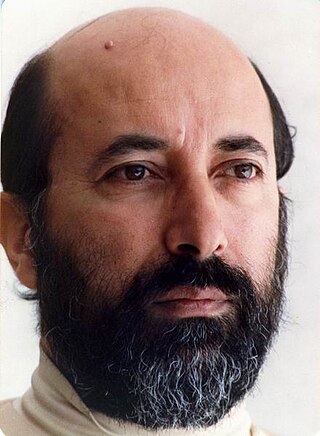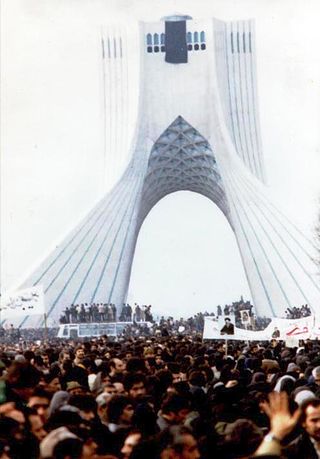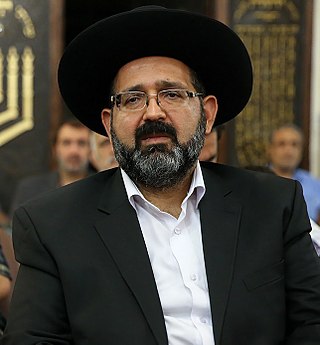
Ayatollah Ruhollah Khomeini was an Iranian Islamic revolutionary, politician and religious leader who served as the first supreme leader of Iran from 1979 until his death in 1989. He was the founder of the Islamic Republic of Iran and the leader of the 1979 Iranian Revolution, which saw the overthrow of Shah Mohammad Reza Pahlavi and the end of the Iranian monarchy. Following the revolution, Khomeini became the country's first supreme leader, a position created in the constitution of the Islamic Republic as the highest-ranking political and religious authority of the nation, which he held until his death. Most of his period in power was taken up by the Iran–Iraq War of 1980–1988. He was succeeded by Ali Khamenei on 4 June 1989.

The Iranian Revolution, or the Islamic Revolution, was a series of events that culminated in the overthrow of the Pahlavi dynasty in 1979. The revolution also led to the replacement of the Imperial State of Iran by the present-day Islamic Republic of Iran, as the monarchical government of Mohammed Reza Pahlavi was superseded by the theocratic government of Ruhollah Khomeini, a religious cleric who had headed one of the rebel factions. The ousting of Pahlavi, the last Shah of Iran, formally marked the end of Iran's historical monarchy.

Hassan Pakravan was a well-known diplomat and minister in the Pahlavi pre-revolutionary government of Iran. He is not only notable for his political involvement with the Mohammad Reza Pahlavi government and SAVAK, but also his relationship with Ruhollah Khomeini.

Persian Jews or Iranian Jews are the descendants of Jews who were historically associated with the Persian Empire, whose successor state is Iran. The biblical books of Esther, Isaiah, Daniel, Ezra, and Nehemiah contain references to the lives and experiences of Jews who lived in Persia. Dating back to biblical times, Iranian Jews constitute one of the world's oldest and most historically significant Jewish communities. Jews have had a continuous presence in Iran since the time of Cyrus the Great of the Achaemenid Empire. Cyrus invaded Babylon and freed the Jews from the Babylonian captivity.

Mohsen Rezaee is an Iranian conservative politician affiliated with the Resistance Front of Islamic Iran and senior military officer in the Islamic Revolutionary Guard Corps, who is currently a member of the Expediency Discernment Council, secretary of the Supreme Council for Economic Coordination, as well as the secretary of the Iranian government's Economic Committee. He was secretary of the Expediency Discernment Council from 1997 to 2021 and Vice President of Iran for Economic Affairs between 2021 and 2023.

Ayatollah Mohammad Mofatteh was an Iranian philosopher, theologian, and political activist, born in Famenin, Hamadan, Iran. After he finished his primary education in Hamadan, he left for the Islamic Seminary in Qom, where he was taught by reputable teachers such as Ayatollah Muhammad Hujjat Kuh-Kamari, Ayatollah Sayyed Hossein Tabatabei Borujerdi, Grand Ayatollah Sayyid Ruhollah Mūsavi Khomeini, Ayatollah Mohammad-Reza Golpaygani, Ayatollah Marashi, and Allameh Tabatabie. He continued his studies at seminary and at the same time studied philosophy at Tehran University, where he earned his PhD and became a professor and a dean of colleague.

Mostafa Chamran Save'ei was an Iranian physicist, politician, commander and guerrilla fighter who served as the first defense minister of post-revolutionary Iran and a member of parliament as well as the commander of paramilitary volunteers in Iran–Iraq War, known as "Irregular Warfare Headquarters". He was killed during the Iran–Iraq War. In Iran, he is known as a martyr and a symbol of an ideological and revolutionary Muslim who left academic careers and prestigious positions as a scientist and professor in the US, University of California, Berkeley and migrated in order to help the Islamic movements in Palestine, Lebanon, Egypt as a chief revolutionary guerilla, as well as in the Islamic revolution of Iran. He helped to found the Amal Movement in southern Lebanon.

Ali Akbar Tabatabaei was an Iranian exile and former press attache to the Iranian embassy in the United States during the reign of Shah Mohammad Reza Pahlavi.

The history of the Jews in Iran dates back to late biblical times. The biblical books of Chronicles, Isaiah, Daniel, Ezra, Nehemiah, contain references to the life and experiences of Jews in Persia. In the book of Ezra, the Persian kings are credited with permitting and enabling the Jews to return to Jerusalem and rebuild their Temple; its reconstruction was carried out "according to the decree of Cyrus, and Darius, and Artaxerxes king of Persia". This great event in Jewish history took place in the late 6th century BC, by which time there was a well-established and influential Jewish community in Persia.
Islamic Revolutionary Court is a special system of courts in the Islamic Republic of Iran designed to try those suspected of crimes such as smuggling, blaspheming, inciting violence or trying to overthrow the Islamic government. The court started its work after the 1979 Iranian Revolution.
The Tehran Jewish Committee, formally registered in 1934, is an umbrella group of Jewish organizations that work on behalf of the Persian Jews in Iran.
Siyamak More Sedgh is a Jewish Iranian politician and doctor who was the holder of the Iranian Parliament's reserved seat for the Jewish minority from 2008 to 2020, and is also the chairman of the Jewish charitable institution Dr. Sapir Hospital and Charity Center. He has been referred to as Iran's "No. 1 Jew."
Religion in Iran has been shaped by multiple religions and sects over the course of the country's history. Zoroastrianism was the main followed religion during the Achaemenid Empire, the Parthian Empire, and the Sasanian Empire. Another Iranian religion known as Manichaeanism was present in Iran during this period as well alongside Christianity, namely the Church of the East. Between 632-654 AD, the Rashidun Caliphate conquered Iran, and the next two centuries of Umayyad and Abbasid rule would see Iran, although initially resistant, gradually adopt Islam as the nation's predominant faith. Sunni Islam was the predominant form of Islam before the devastating Mongol conquest but subsequently, Shi'ism eventually became the predominant faith in Iran with the advent of the Safavid Empire (1501-1736).

Casualties of the Iranian Revolution refers to those who lost their lives during the Iranian Revolution. Observers differ on how many people died during the Iranian Revolution. The Islamic government uses the figure of 60,000 killed; in reference to this figure, the military historian Spencer C. Tucker notes that "Khomeini's regime grossly overstated the revolution's death toll for propaganda purposes". The sociologist Charles Kurzman, drawing on later more detailed records from the Islamic Republic, believes the number was closer to 2,000-3,000.

Exodus of Iranian Jews refers to the emigration of Persian Jews from Iran in the 1950s and the later migration wave from the country during and after the Iranian Revolution of 1979, during which the community of 80,000 dropped to less than 20,000. The migration of Persian Jews after the Iranian Revolution is mostly attributed to fear of religious persecution, economic hardships and insecurity after the deposition of the Imperial government.

Mir Asadollah Madani Dehkharghani was an Iranian politician and Shia cleric. He was the second Imam Jumu'ah of Tabriz, the Imam Jumu'ah of Hamadan, the representative of the Supreme Leader in East Azerbaijan for less than a year, and a member of the Muslim People's Republic Party. Madani was also Hamadan Province's representative in the first term of the Assembly of Experts.

The Fajr decade is a ten-day celebration of Ruhollah Khomeini's return to Iran in 1979. The annual celebration is held between 1 and 11 February. Its beginning coincides with the date of Khomeini's arrival and ending with the Iranian Revolution; a day called Islamic Revolution's Victory Day or 22 of Bahman.
"Iran and Red and Black Colonization" was an article written by Ahmad Rashidi Motlagh published in Ettela'at newspaper on 7 January 1978. The article was used to attack Ruhollah Khomeini, described as an Indian Sayyed, who later founded the Islamic Republic of Iran. It led to the 1978 Qom protest.

Rabbi Younes Hamami Lalehzar is the current religious leader of Iranian Jews.

Ruhollah Khomeini's life in exile was the period that Grand Ayatollah Ruhollah Khomeini spent from 1964 to 1979 in Turkey, Iraq and France, after Mohamed Reza Shah Pahlavi had arrested him twice for dissent from his “White Revolution” announced in 1963. Ayatollah Khomeini was invited back to Iran by the government, and returned to Tehran from exile on 1979.













